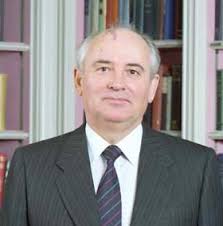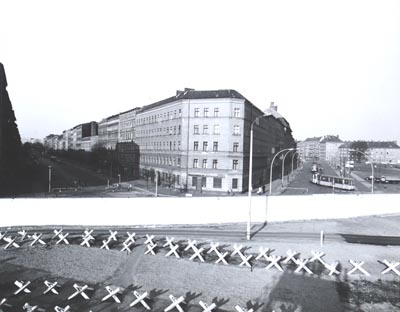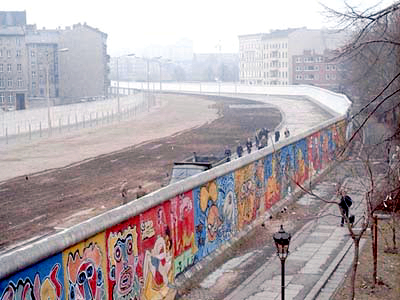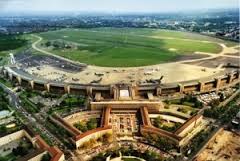
Mikhail Gorbachev was instrumental in the fall of the Berlin wall and the end of the cold war.

"The Anti Fascist Protection Barrier".

The Berlin wall was used as a canvas for many artists.

Berlin Airports
During the blockade of Berlin by the Russians the Allied part of the city had to be supplied wholly by the air, making the Berlin airports crucial to the survival of the Western part of the City. The crisis of the separation of Germany and Berlin into two parts, that of the allies (USA, UK & France) and USSR, this was one of the first crisis of the cold war.The growing differences between the former allies made the question of Berlin one of the key themes of the Cold War. Abandoned negotiations to agree a common political status for Germany, representatives of the USA, Britain and France met and signed agreements London (April-June 1948) to start a constitutional process in their zones of occupation .
The June 18, 1948, the Western Allies went a step further, creating a new currency for their occupation zones: the Deutschemark. The Soviets responded by applying a reform in the area that included the city of Berlin, which they considered an integral part of the Soviet zone. When Westerners tried to spend Deutschemark`s in their occupation zones of Berlin, Soviet protests turned into action: the "Berlin Blockade" was initiated. By disrupting any land communication between Western occupation zones and West Berlin. On 24 June, on the pretext of restoring some bridges over the Elbe, it is suspended traffic on the highway, railways and canals linking Berlin with West Germany. The main factor It allowed to carry out the Berlin blockade by the Soviet Union was given essentially from the fact that among the four occupying powers had never negotiated agreements on access to Berlin, they had not been explicitly agreed.
According to the Soviet perspective, we know through the Compendium of History of the USSR (1966), the reason for the impasse is essentially explained from the behavior of the Western powers to end the Potsdam agreements, referred to quadripartite control of Germany. This situation would have manifested in the implementation of monetary reform carried out separately in June 1948. "On June 20, unexpectedly announced separate currency reform in the three Western zones, secretly prepared. Old German marks flowed immediately devalued East Germany, creating the risk of causing enormous damage to the economy of this area. In response the Soviet authorities had to take urgent action. In order to shut out the speculators control of goods and passengers from West Germany it was established. The Soviet military administration ordered that they take care of the entire supply of West Berlin, as far as food was concerned, so that people would not suffer hardship. But Western occupation authorities were opposed to it. "
From this perspective, "air bridge" organized by the United States would have been a mere propaganda machine, as it was unnecessary because the Soviet Union had been paid to deliver supplies to West Berlin.
Before the Berlin blockade the Western reaction was swift. The Americans, with British aid, organized an airlift for eleven months and by more than 275,000 flights into the airports of Berlin succeeded supply the besieged population. At the same time, the White House had informed the Kremlin would not hesitate to use force to enforce the "air corridors" linking Berlin with West Germany.
At this time the Berlin crisis becomes a typical conflict of the Cold War. Both parties measured their strength and determination. The Soviets measured the Western will, while the US gave proof of firmness. They refused to leave Berlin, but made no direct aggressive gesture against the Soviet Union. In fact, this type of offensive and reactions will be repeated throughout the Cold War. Each party was considering a set of calculated risks, trying to stand back whenever the risk of a direct and open conflict came close to arise.
On May 12, 1949, Stalin lifted the blockade of Berlin. But the final division of the city had already begun to take shape. The May 8, 1949 the Basic Law of the future Federal Republic of Germany was adopted. This constitution established a democratic liberal system and was approved by the Western powers. In September of that year, Konrad Adenauer was elected its Chancellor. For its part, the Soviet Union, said the October 7, 1949, with the proclamation of the constitution of the GDR, a state created on the model of the "popular democracies". After the crisis, the uncertainty regarding the legal authority over access to Berlin remained just as indefinite as they never took place agreements between the parties.
This partition of Germany was the realization in the heart of Europe of the bipolar division of the world: just a few days earlier, on April 4, 1949, was signed in Washington the North Atlantic Treaty, in which it undertakes the last step consolidate the blocks, now from a military point of view.
